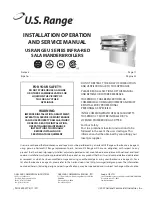
Brute Mini JV
Page 17
5B By-pass Piping
The following information and suggestions are made
on by-pass piping as it affects the temperature rise
at the boiler. A boiler temperature rise must be taken
on all JV boiler installations. If the temperature rise
exceeds 30°F (17°C) at full rate, it is an indication that
the boiler is not receiving adequate water flow. Check
the pump for any obstruction, replace the pump with a
larger size where necessary, or install a system by-pass
as indicated in
Figures 10 and 11.
A full sized, 1¼" bypass with balancing valves is
strongly recommended for all systems, and required
when: 1) the boiler is installed without primary-
secondary piping in a multiple zone system; 2) when
the return water temperature can be expected to be
lower than 120°F (44°C); or 3) whenever the system
piping on the outlet side of the boiler may allow
reduced flow through the heat exchanger, causing
excessive temperature rise (see Section 5.2).
Note:
Bradford White strongly recommends a primary/
secondary piping system for all installations, especially
sizes 125, 160 and 225. In this system, a circulator is
dedicated to pumping the boiler only. This circulator
should be sized for the boiler head loss and flow rate.
All precautions must be taken by the installer to insure
that a maximum temperature rise through the boiler
does not exceed 30°F (17°C). The temperature rise
on boilers installed in multi-zone systems using zone
valves must be taken when the zone of the longest
length and/or the zone of the highest head loss is open.
A full size, 1¼" diameter by-pass with
balancing valve must be installed if a return water
temperature below 120°F (44°C) is expected under
operating conditions regardless of boiler size. This
may be expected in many systems, including in-
floor radiant and snow melt systems.
5C Adjusting the bypass:
Refer to
Figure 11
. Provide a means of measuring
temperature on the inlet pipe to the boiler such as
using a strap on or infrared thermometer. Starting
with both balancing valves fully open, start the boiler.
Adjust the balancing valve on the return to the system
slowly to provide 120°F (44°C) water at the inlet to
the boiler, leaving the bypass balancing valve fully
open. As the system warms up, this valve may need
to be adjusted open. In rare cases, this valve will have
to be kept fully open, and the bypass balancing valve
adjusted toward closed to prevent heated bypass water
from satisfying the call for heat when the system is up
to temperature.
5D Alternate Auto-Bypass Operation
Use of the Bradford White thermostatic union, p/n
2400-030, can provide automatic bypass operation in
primary - secondary piped systems (but cannot be used
when primary - secondary piping is not used). The
thermostatic union is installed on the outlet piping,
after the bypass assembly. It can be used in place of a
balancing valve. It opens fully at 140°F
(see Figure 11)
. Contact the factory for more
information.
Table 7. Temperature Rise °F
°C
.
gpm = Water Flow in gallons per minute.
l/s = Water flow in liters per second.
ft = Pressure drop (headloss) through the boiler in feet of water.
m = Pressure drop (headloss) through the boiler in meters of water.
Notes: 1. Shaded area is the recommended flow and temperature rise.
2. Temperature rise and associated flow rates are based on high fire operation at the Normal Input Rate from the rating plate.
15°F
8°C
20°F
11°C
25°F
14°C
Size
Flow Rate
Headloss
Flow Rate
Headloss
Flow Rate
Headloss
gpm
l/s
ft
m
gpm
l/s
ft
m
gpm
l/s
ft
m
50
5.3
0.3
0.3
0.1
4
0.3
0.2
0.1
3.2
0.2
0.1
0
75
8
0.5
0.6
0.2
6
0.4
0.3
0.1
4.8
0.3
0.2
0.1
100
10.7
0.7
1.3
0.4
8
0.5
0.7
0.2
6.4
0.4
0.5
0.2
125
13.3
0.8
2.2
0.7
10
0.6
1.3
0.4
8
0.5
0.8
0.2
160
17
1.1
2.5
0.8
12.8
0.8
1.8
0.5
10.2
0.6
1.2
0.4
225
24
1.5
5
1.5
18
1.1
3.1
0.9
14.4
0.9
1.9
0.6
















































